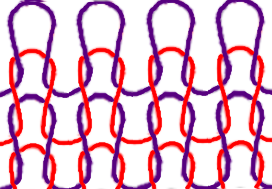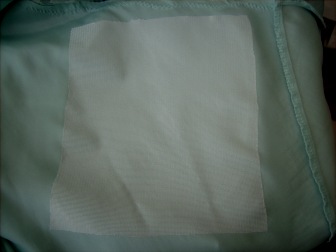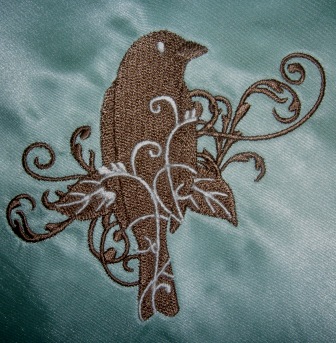I have been thinking about doing embroidery on lingerie for some time now. I might be doing some laces or even some more dense design. I love embroidery and figured a little bit of additional color would be great.
A great deal of lingerie today is made from nylon and/or polyester tricot. Tricot is a ‘warp-knit’ which can be woven with nylon, cotton, wool, silk, rayon and almost any other type of fiber or fiber blend. Warp-knitting, shown on the left is when the yarn zigzags with the length of the fabric. Standard knitting by contrast is normally done in a line by line (or variation thereof) stitching. On the right is ‘stocking knit,’ a commonly used knit stitch.


The texture of tricot is different from stocking knit. Ribbing runs in a lengthwise, and the opposing side runs crosswise. The result is a soft and sturdy fabric with many uses like undergarments and lining for sleeping bags. It is also used in camouflage as a durable and breathable cover. Since silk is so delicate, manufacturing it in the tricot method makes it a stronger, more long-lasting and carefree fabric to wear often.
Tricot holds its shape; therefore sagging is not an issue. The breathability makes it a year round fabric comfortable for lingerie, gowns and undergarments. Since it is made from natural and/or manufactured yarns, the coloration is limitless.
Tricot is listed with its ‘denier’ number which is a weight calculation for yarn. While there are a number of computations for denier, for simplicity, it is approximately the “mass in grams of a 500-meter length which is divided by 0.05.” Got that?? Well, the smaller the number, the heavier the yarn.
I selected a nightgown to embellish. I am putting a ‘sparrow’ on the left side of the skirt.
I started out purchasing some fusible tricot. I never heard of it before, but my embroidery dealer was telling me about it during one of their wonderful monthly meetings. I wish I could bring all of you to these meetings because we share, laugh and learn at them. So I fused my tricot to my underside of the gown. Just a few moments of ironing and it was done.

I followed that important rule about using a very fine needle for this since my project is on a soft, fine fabric. I used a number 70/10 sharp (as opposed to a ball point) needle. I did slip an extra piece of water soluble stabilizer which was just under the hoop.
I selected a soft brown and cream color for the thread. I do almost exclusively use Madeira, and the design was digitized for Madeira with a darker brown and a light blue highlight. I change my colors whenever I choose and I really liked this combination. The gown is a pale blue so the contrast is just wonderful.

This does bring me to another point. I don’t always agree with the coloration of the digitizer. A really good digitizer must not only be able to digitize but also be an artist and a colorist with a really good eye for creating beautiful work.
I want to examine digitizing because so many people purchase an embroidery machine and want to start digitizing rather quickly thereafter. The whole concept of embroidery and making your own designs is fascinating to newbies (we love you!!). A newbie sees creating designs for a child, grandchild or other loved one; they get stars in their eyes about the uniqueness of doing something all by themselves.
Let me assure you that you may well have all the necessary criteria to be a ‘master digitizer’ but such things do take time and a great deal of practice. Let me show you a couple of designs which will help you understand what I am saying.
With apologies to the unknown ‘beginning digitizer,’ here is what I mean.


2nd Photo courtesy of Emblibrary.com
The first dog was done from a clip art; and we can and do use this dog caricature in a lot of ways. Simple art work is where a new digitizer begins, and we all have to start somewhere! But, they might have done a few things to make it more interesting such as slanting the ears and tail to mimic the actual growth of hair. They might have added some shading creating some depth to the dog. If you look at the mouth, it is in the same ‘plane’ as the collar, making it flat and lacking in dimension.
The second dog, done by a very experienced digitizer shows the mouth separate from the neck, the eyes have life, and muscles and other details right down to the nails are accurate. I personally sewed out the second dachshund and each of the layers on the front chest have been placed incrementally so that the white peeks through each upper layer creating depth and personality for the dog. I actually ran my hand down the dog and it felt like a soft, smooth coat.
Getting to the point of creating something similar to the second picture takes a lot of work and knowledge of digitizing, anatomy and life colors.
Do give digitizing a try and just have fun with it.